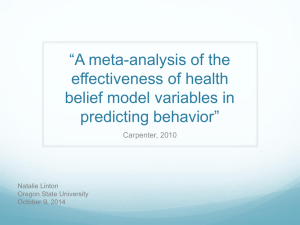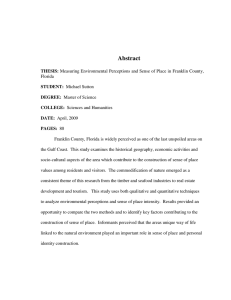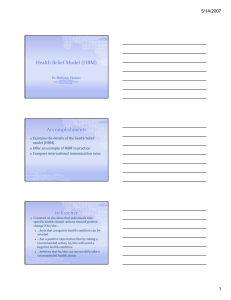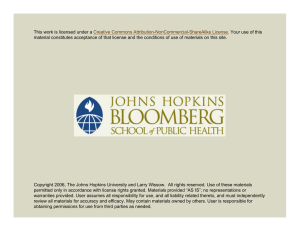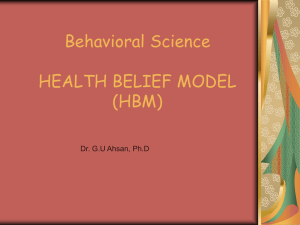The Health Belief Model
advertisement
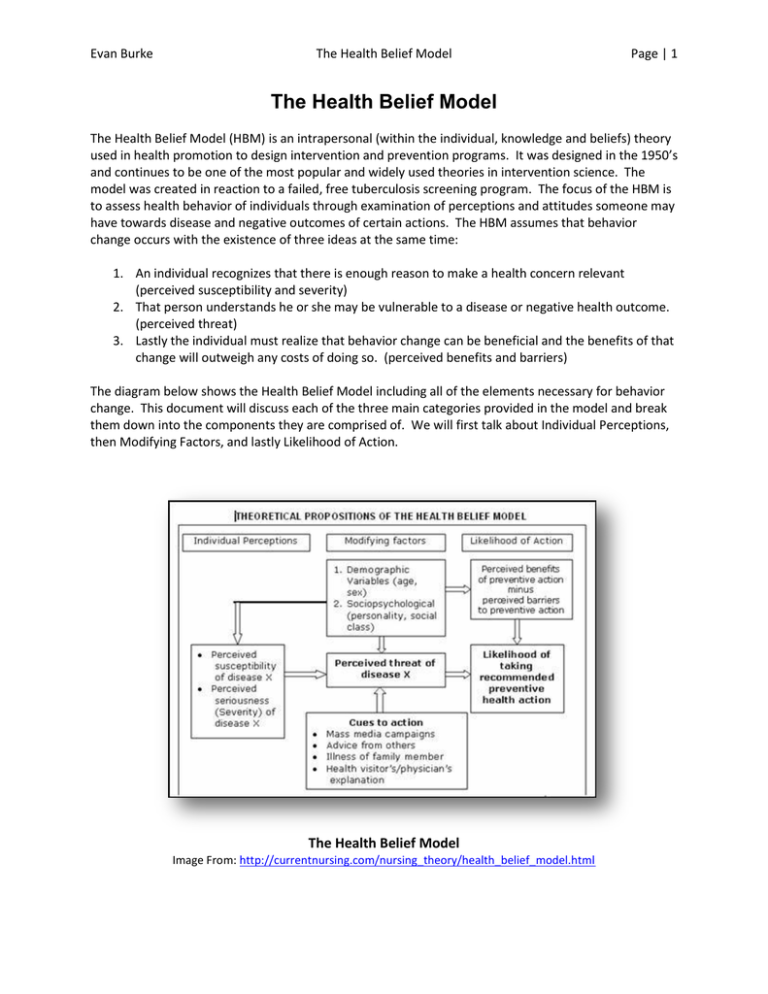
Evan Burke The Health Belief Model Page | 1 The Health Belief Model The Health Belief Model (HBM) is an intrapersonal (within the individual, knowledge and beliefs) theory used in health promotion to design intervention and prevention programs. It was designed in the 1950’s and continues to be one of the most popular and widely used theories in intervention science. The model was created in reaction to a failed, free tuberculosis screening program. The focus of the HBM is to assess health behavior of individuals through examination of perceptions and attitudes someone may have towards disease and negative outcomes of certain actions. The HBM assumes that behavior change occurs with the existence of three ideas at the same time: 1. An individual recognizes that there is enough reason to make a health concern relevant (perceived susceptibility and severity) 2. That person understands he or she may be vulnerable to a disease or negative health outcome. (perceived threat) 3. Lastly the individual must realize that behavior change can be beneficial and the benefits of that change will outweigh any costs of doing so. (perceived benefits and barriers) The diagram below shows the Health Belief Model including all of the elements necessary for behavior change. This document will discuss each of the three main categories provided in the model and break them down into the components they are comprised of. We will first talk about Individual Perceptions, then Modifying Factors, and lastly Likelihood of Action. The Health Belief Model Image From: http://currentnursing.com/nursing_theory/health_belief_model.html Evan Burke The Health Belief Model Page | 2 Individual Perceptions Individual perceptions speak directly to the knowledge and beliefs that a person has about his behaviors and the outcomes they could have. This section of the paper includes two main sections; Perceived Susceptibility and Perceived Severity. A. Perceived Susceptibility Within the health field susceptibility refers to the risk a person has to a particular disease or health outcome. Within the context of the HBM, perceived susceptibility examines the individual’s opinions about how likely the behaviors they partake in are going to lead to a negative health outcome. For example, look at an individual who smokes. Smoking is known to have many complications such as lung cancer, bladder cancer, etc. If a smoker does not feel that he is at risk of developing any of these diseases, he has no reason in his mind to make a behavior change. One of the Goals of the HBM is to change perceptions of susceptibility in order to move towards behavior change. B. Perceived Severity Most people are familiar with the word severity as how serious a situation or action can be. In the HBM perceived severity addresses how serious the diseases that a person is susceptible to can be. In the case of a smoker, lung cancer is one of the leading causes of death among the American population. A smoker may not understand how difficult lung cancer can be to detect and how difficult it can be to treat. They also may not know how painful and long lasting a disease it can be later in life. The HBM seeks to increase awareness of how serious the outcomes of behaviors can be in order increase the quality of one’s life. Now that there is an understanding of Individual Perceptions it is important to understand how Modifying Factors can affect some ones decision to change. Modifying Factors While Individual Perceptions were internalized, In the Health Belief Model Modifying Factors step outside the body to examine and use outside influences to affect the how threatened a person feels by the outcomes of continuing the same behaviors that put him at risk. As seen by the arrows in the diagram, perceived susceptibility and severity do have their own impact on threat as well. A. Perceived Threat Susceptibility as stated before displayed how someone acknowledged that their behavior could lead to a specific disease. Threat takes the idea one step further by examining just how likely it is that the disease could be developed. To use lung cancer again, someone who has been smoking for a year may not feel threatened by potential disease because they have not been doing it very long and if they quit their body can recover. On the other hand, a smoker who has been doing so for 25 years may feel very threatened by lung cancer if he has developed a strong cough. The cough could be a symptom that increases his level of threat and triggers his decision to quit. B. Environmental Factors Environmental factors can add to the threat of disease. Demographic background can cause one to be more at risk such as race, ethnicity, and socioeconomic status. Someone living in poverty Evan Burke The Health Belief Model Page | 3 would be more threatened by a disease if they could not afford health care. Also Peers and other influential people can have an influence. If an entire group of friends smoke together, it is going to be more difficult for one person to quit. C. Cues to Action Lastly cues to action are reasons why an individual realizes he could be threatened by serious disease. These could be media or concerned loved ones. Cues to action are anything that triggers a decision to change behavior. The previous two categories have built on each other and lead to Likelihood of Action. Likelihood of Action After becoming aware of the potential for developing a disease if behavior does not change, it is important to weigh out the benefits and the barriers to taking action and determine if it is worth it. A. Perceived Benefits What are the benefits to change? In the HBM the goal is greater quality of life for an individual both mentally and physically. Clearly a benefit to change would be increased health but there could be other factors that exist on an individual level. B. Perceived Barriers What are the reasons that I cannot change my behavior? Barriers could be anything from losing friends to not having enough money or even self-efficacy problems such as not believing in one’s self. For change to take place the benefits must be stronger than the barriers. Conclusion The Health Belief Model is a simultaneous process used to encourage healthy behavior among individuals who put themselves at risk of developing negative health outcomes. A person must evaluate their perceptions of susceptibility and severity of developing a disease. Then it is necessary to feel threatened by these perceptions. Environmental factors can contribute as well as cues to action such as television ads or caring relatives. Lastly the benefits to change must be weighed against the barriers to change behavior in order to determine that taking action will be worthwhile.

